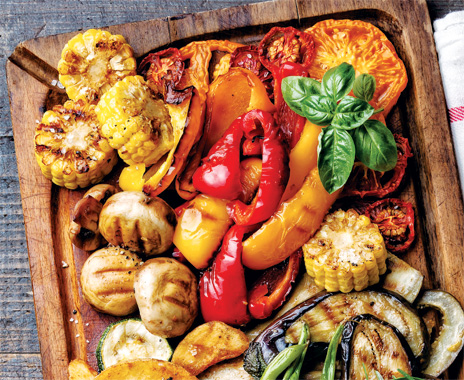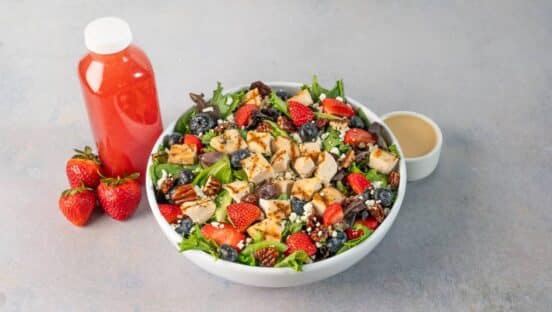For many of us, the sound of our moms’ admonition to eat our vegetables still echoes through our memories. But no chiding is necessary for an increasing number of Americans. The inherent health benefits of veggies have been buttressed by innovative and creative chef-inspired recipes that make even committed carnivores crave these ingredients.
And while salads have been part of the limited-service restaurant universe for decades, guests are seeking more than chopped lettuce. These days, they’re trying more dishes with asparagus, beets, and Brussels sprouts.
“You can see this across the entire marketplace,” says Jana Mann, senior director of syndicated service for market research firm Datassential. “People are being introduced to new and different vegetables. Instead of tomatoes, onions, and mushrooms, restaurants are featuring or calling out something like a varietal, so the tomato is a cherry, or grape, or even heirloom tomato, and a mushroom is a portobello or another variety.”
While tomatoes are scientifically fruits because they have seeds, chefs generally consider them vegetables because—like cucumbers, peppers, squash, and some other seeded fruits—they are savory rather than sweet.
Veggies are also gaining favor due to the movement toward unadulterated recipe elements. “You’re seeing the use of fresh and clean vegetables and other ingredients prepared right in front of us,” Mann says.
“People desire to eat less red meat, but they’re still looking for high flavor,” adds Danny Bendas, managing partner of Synergy Restaurant Consultants in Newport Beach, California. “There are now a lot of chef-inspired dishes roasting and grilling vegetables.”
Although vegetables are considered by many to be healthier, the overarching goal, he says, is to have clean food. “It’s more important than calories and fat,” Bendas says of the rise in clean-label foods. Organic and local are even better as long as they are feasible, affordable, and good quality.
Veggie-centric eating is particularly appealing to Millennials, Bendas says. That is backed by a Harris Poll survey last year for Subway that found Millennials consume more vegetables than any other generation.
“Millennials have more of a self-awareness of how they look and feel,” says Lanette Kovachi, Subway’s global dietician. “The Millennial generation was also brought up to appreciate vegetables more, and they have been introduced to more vegetables.”
While the percentage of vegetarians isn’t growing, she says, “there are a lot more flexitarians trying to choose more vegetables or mixing it up throughout the week,” referring to people with a vegetable diet mixed with occasional meat or seafood.
Many limited-service restaurants, from Taco Bell to Wendy’s, have long had menu items that are also vegetarian. Subway’s most recent vegetable addition to its core menu was spinach in 2013, and the company is “looking at more vegetable toppings,” Kovachi says.
The Harris Poll survey found tomatoes and lettuce are the most popular veggies, and Datassential ranks onions and tomatoes as tops in menu mentions. Kale is the fastest-growing vegetable on menus, followed by broccoli.
Often overlooked are potatoes. Although best known for french fries, potatoes are also showing up in other ways, particularly in breakfast menus, says Don Odiorne, vice president of foodservice at the Idaho Potato Commission.
“There is a push at breakfast to acknowledge the price of eggs has gone up a bit, so potatoes are a great way to stretch an item,” he says.
A number of limited-service restaurants have potatoes that are mashed, baked, loaded, or hash browned, while some are featuring poutine. Odiorne expects that speedier ovens will lead operators to consider adding more potato items that don’t require a fryer finish.
Bendas says all age groups, not just Millennials, are eating more varied vegetables.
“When I was a kid, no one ate Brussels sprouts, and now they’re everywhere,” he says. “You’re seeing vegetables grilled, seared, and sautéed. People want a lot of flavor and also want to be healthy. But they’re also not looking to go too far outside the box.”
The rise in vegetables’ popularity has made it possible for some limited-service concepts to focus almost entirely on vegetables. At Beefsteak in Washington, D.C.—owned by renowned chef José Andrés’ ThinkFoodGroup—there’s no beef. The name refers to the tomato variety.
“There’s an amazing variety of fresh vegetables,” says Jim Biafore, director of operations for the two-unit enterprise. “As we go through the growing season with our vegetables, not only do we have the freshest ones, but also some of the more unique ones.”
At any one time, Beefsteak features about two dozen local veggies. Some, like broccoli and carrots, are always on the menu because they can be procured fresh year-round. Others, including Brussels sprouts and asparagus, are seasonal.
The menu offers dishes like Kimchi-wa, which has rice, corn, carrots, cabbage, edamame, bok choy, scallions, kimchi, and other ingredients. Diners also can make their own bowls with a grain base, vegetables, and sauces. Proteins like salmon or chicken are available.
There is even a “burger” on the menu; it’s a slice of beefsteak tomato combined with pickled red onions, sprouts, olive oil, dressing, and sea salt on a brioche bun. “It eats like a burger, has nice mouthfeel, and is just as flavorful as any meat item,” Biafore says.
Veggie burgers have been on the menu at some quick serves for years, and just as the effort to make better burgers has increased, so have attempts at better veggie burgers. That’s the case at BurgerFi, based in Delray Beach, Florida.
“We thought if we put in the energy, time, and research and development, we could be a game changer with a burger that appealed to non–meat eaters and women,” says Steve Lieber, one of the concept’s creators. He adds that it also appeals to those wanting a break from meat.
The company, which has more than 80 restaurants, created the VeggieFi, which has a burger that starts with a quinoa base and adds mushrooms and onions sautéed in a wine reduction, lentils, carrots, zucchini, and various binding and flavor ingredients.
The VeggieFi—the choice of an eighth of customers—is fried or grilled and served with cheese, lettuce, tomato, and special sauce on a multigrain bun or a lettuce wrap. Lieber says BurgerFi also makes use of other vegetables, including beer-battered onion rings and Idaho potato french fries.
[pagebreak]
On the other side of the country, in San Francisco, Eatsa has quinoa as the base for its bowls, but local vegetables “are absolutely critical,” says cofounder Scott Drummond. “Our customer is looking for a lot more flavor forward, so we do play into that.”
Eatsa is a three-unit vegetarian fast casual without employees; customers order through kiosks and pick up their choices in designated drop-off bins. There are 37 veggie ingredients on the menu, from curried parsnip strips and apple-cabbage slaw to roasted corn and seasoned pinto beans.
“Certainly things like crunch—the texture—are obvious and very much a part of the meal,” Drummond says. “It’s nailing the cook times so that you have a product fresh off the grill” that provides great flavor and aroma.
Some veggies are offered in various styles. For instance, portabella mushrooms are presented three ways: grilled in the Burrito Bowl, miso in the Bento Bowl, and barbecued in the Smokehouse Salad. Seasonal vegetables also come into play, as in the Stuffing Bowl, a fall offering with roasted autumn veggies, green beans, onion strings, mushroom gravy, almonds, cranberry chutney, and a quinoa stuffing.
Whole foods are key to the menu at Phoenix-based Grabbagreen, and vegetables are a large part of that—in juices, smoothies, grain bowls, salad bowls, and breakfast.
“When we developed our menu, our focus was to choose nutrient-dense ingredients,” says Keely Newman, president and chief executive of the three-store chain. The vegetables run the gamut, from typical cucumbers, red peppers, red onions, and tomatoes to a bit different, including edamame, beets, and bean sprouts.
The concept is not chef-based but “mom-inspired,” Newman says. “We started as two moms and how we ate at home and how we fed our children,” she says. “The menu is very health-driven. We knew what tasted good because kids are finicky. These are all kid tested.”
There are a number of signature bowls on the menu, as well as create-your-own options that have a base of grains or greens; five super-nutrient toppings of vegetables, fruits, nuts, or other items; a sauce; and a meat or vegetable-based protein. One breakfast item is a wrap with collard greens in place of tortillas. The founders were raised in Mississippi, “so collard greens are indigenous to what we ate when we grew up,” Newman says.
Vegetables popular in other cultures play a role in how they are used by American restaurants featuring various ethnic cuisines.
“They have always been very important to Mexican cooking, especially the Baja style,” says Ralph Rubio, founder and chairman at Rubio’s Coastal Grill, referring to his concept’s signature cuisine.
Since the San Diego–based chain’s early days, cabbage has been a component of the fish tacos. “I discovered that in San Felipe, a lot of Baja taco vendors liked to use cabbage because it didn’t wilt,” he says. “It also gives it a crunch.”
Various other veggies—onions, tomatillos, beans, corn, and hot and mild peppers—are included in dishes and salsas. As part of the chain’s rebranding, zucchini and squash were added to its grilled vegetable mixture of onions and red, green, and yellow peppers.
“When we revisited it, we wanted something hardier, and zucchini and squash accomplish that,” Rubio says. The grilled vegetable option also was added to the menuboard alongside steak and chicken as non-seafood choices for burritos and tacos.
Tin Drum Asiacafé features onions, mushrooms, carrots, and various hot and mild peppers, along with broccoli, cabbage, potatoes, scallions, green beans, and bean sprouts.
“When we look at an entrée, we want vegetables to be every bit as much an element of the dish as the protein,” says Jon Schinelli, director of operations for the Georgia-based company. “They all work together.” Rotating new menu items every three months “allows us to play with even more vegetables and more contemporary vegetables,” he adds.
That’s the case this winter with the Daikon Bacon Fries that use daikon, a mild radish, rather than potatoes. Napa cabbage, a traditional Asian veggie, is part of the slaw on Tin Drum’s street tacos, while a dish like Masaman Curry features potatoes, carrots, cucumber, onions, peanut curry, chicken, and rice. Dishes with sweet potatoes may join the menu this year.
One popular way for consumers to consume vegetables is on pizza. Bell peppers, tomatoes, onions, and mushrooms have long been an element of the American pizza scene, but some pizzerias are looking to add even more.
At Dallas-based Pie Five, vegetables are “a big part in designing signature recipes for our concept,” says Patty Scheibmeir, vice president of R&D and product innovation for parent Rave Restaurant Group. “They bring color to a pizza, flavor, and an important part, which is texture that comes from crisp, fresh vegetables that you can’t get from meat or cheese.”
Ingredients like red, green, and banana peppers; red onions; and jalapeños retain crunch because the pizzas are made with a very hot, quick bake. Other veggies, like sliced mushrooms, tomatoes, and spinach, “bring great flavor,” she adds.
Along with traditional vegetables, Pie Five offers marinated artichoke hearts, sundried tomatoes, caramelized onions, and roasted tomatoes. A specialty pizza in the Chicago market features giardiniera, an Italian-influenced relish of pickled vegetables.











